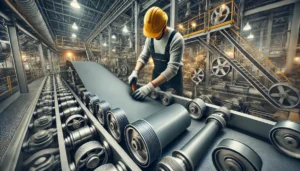Industrial valves are significant in the maintenance of liquid and gaseous compartments in different systems. These valves must be appropriately maintained in order to achieve longevity and optimal performance in sectors such as oil and gas, water treatment, and power generation. With the right maintenance strategies, industries can avoid untimely failures, cut down on downtime, and increase the service life of the valves.
1. Consistent Checks
Regular checks on the valves inspect valves for leaks, cracks, gray areas, and metals that have been eroded. This strategy helps nurses identify issues much before the problems escalate. If timely diagnoses regarding the failure of the valves are made, attempts can be made to correct the issue before costly repairs have to be made. Inspections of valves should focus on examining closing and opening leaks, alignment of the valve stems, and verifying closure of valves. Additionally, movement and response time of the valve also has to be inspected to ensure it closes and opens as required.
2. Cleaning and Lubrication
To ensure smooth operation, keeping the valve clean is deemed very crucial. Movement impediments from dirt, other debris, and even mineral deposits in and around the valve components can contribute towards its dysfunctionality. For removing blockages without damaging the valve, appropriate cleaning agents along with wear-and-tear preventive agents must be used. After the valve is cleaned, it is important to provide lubrication to moving parts like stems, seals, and actuators. With proper lubrication maintenance, friction is reduced, corrosion is prevented, and the valve can operate even in high-stress conditions without issues. A lubricating agent compatible with the valve material and operational conditions must be used as prescribed by the manufacturer.
3. PM Schedule Maintenance
To prolong the lifespan of industrial valves, a proactive PM program must be designed and adhered to. Along with the type of media flowing through the valve, it is necessary to factor in the temperature and pressure conditions as well as the frequency of operation, when setting maintenance intervals. All valves operating under high-pressure, high-temperature, or any other corrosive fluids, will require more frequent checks to maintain the overall integrity of the valve. Adopting a proactive PM program allows for effective and sudden failure’s reduction, optimization of valve performance, and renders the incorporation of unplanned downtime utterly unnecessary.
4. Monitoring Performance Of A Valve
Advanced monitoring tools can track valve performance over time, checking if there are discrepancies in how the valve should perform. For example, the flow rate, pressure, and temperature of the valve can be recorded. If a valve is equipped with modern sensors, it can let the user know if it is performing poorly. These metrics can give clues to abnormal behavior. For example, a valve may not open or close at all. It can also remain in a single position. These active metrics help catch the problems at an early stage. A lower threshold for the problem also helps reduce the need for preventive action as inadequate performance can be detected early with the help of the monitoring system. Having such systems improves the overall management of the valve by reducing maintenance efforts and preventing issues prior to them leading to a breakdown.
5. Proper Handling And Storage
Premature wear and damage can occur due to improper storage and usage of valves not in operation. To ensure that no contaminants get to the valve, proper sealing has to be done. Any attempt at dealing with installed or uninstalled valves should be done with extreme care and precision. Seals, stems and flanges can easily get damaged if valves are not lifted and moved with the appropriate techniques. Not doing so can impact performance when the valve is put back in. Corrosive substances, dirt, and moisture can also cause the internal components of the valve to become damaged which is why the valve should be kept in a clean and dry place.
6. Training and Documentation
The assigned personnel responsible for the maintenance of the value shall be trained on procedures and safety measures that are in place. This also encompasses knowing the kinds of valves being operated, their maintenance, and the troubleshooting processes. Employees should be provided refresher sessions to keep them updated with the changing technologies, safety requirements, and industry best practices. In addition, proper documentation is critical when it comes to tracking all maintenance activities performed on the valve. Reports should capture the details of the inspections and the repairs or replacements performed on the valves together with any alterations done to them. This assists in the evaluation of the performance of the respective valve over its life cycle and helps in recognizing any problems that manifest repeatedly enabling them to be fixed.
7. Adherence to Manufacturer’s Guidelines
Ignoring best practices in valve maintenance, as in many other processes, can result in detrimental consequences. The specifications and suggestions put together by the manufacturers constitute as the recommended best practice. The makers provide important details about which lubricants, cleaning agents, and other maintenance practices are appropriate for each type of valve. Contrary to popular belief, following the guidelines is very important as not doing so may result in severe damages, performance loss, and even worse, warranty rejection. Certainly one factor does always remain constant and that is, the use of improper materials and maintenance procedures will certainly reduce the performance life of the valve and increase the risks of leaks, operational inefficiency, and worst case, a complete breakdown.
8. Putting into Practice Valve Exercising
Exercising the valve, where maintenance entails periodically opening and closing the valve, is essential for exercising mechanisms under stationary conditions for long durations. In water distribution networks, it’s important for valves that remain in a closed position or that are used infrequently. Regularly cycling the valve makes it possible for operators to avoid corrosion, scale, or debris buildup that would otherwise impede a valve’s movement when it is needed. Additionally, by regularly exercising the valve, operators can ensure that it remains functional.
9. Maintenance of Sealing and Packing
The seals and packing within the valves play an important role in the maintenance of system pressure and the prevention of leakage. These components are prone to wear and tear from chemical exposure, mechanical wear, or high temperatures. Regularly checking the condition of seals and packing material is essential for effective valve performance. Resealing or repacking is sometimes required in order to contain leakage. Properly maintained seals can conserve costs and avert expensive fluid waste.
10. Routine Verification and Adjustment
Routine verification and adjustment of valves is crucial in the functioning of industrial valves. For a valve to open, or close at a particular pressure, it needs to be calibrated. Testing is done during normal operations to check the performance of the control element and to validate that the valve works as intended under different operating states. Addressing noncompliance with expected performance must be done promptly, as anything else could lead to system ineffectiveness or safety issues.
Conclusion
The reliability and efficiency of valve systems in different fields of operations heavily relies on the careful servicing of industrial valves. The timely service checks, removal of dirt, services such as oiling, and parametric monitoring are essential in preventing increased valve wear and maintaining functionality. Following instructions from the manufacturer, as well as performing proactive maintenance procedures and regular testing of valves, greatly increases the useful life of the equipment. The cost savings and system uptime, as well as the enhanced safety and reliability of the system, are all offered by keeping valve systems in top working condition.










